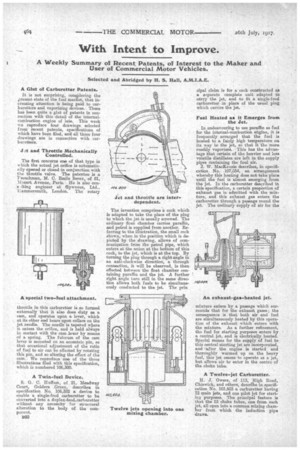With Intent to Improve.
Page 20

If you've noticed an error in this article please click here to report it so we can fix it.
A Weekly Summary of Recent Patents, of Interest to the Maker and User of Commercial Motor Vehicles.
Selected and Abridged by H. S. Hall, A.M.I.A.E.
A Glut of Carburetter Patents.
It is not surprising, considering the present state of the fuel market, that increasing attention is being paid to carburetters and vaporizing devices. There has been quite a glut of patents in connection with this detail of the internalcombustion engine of late. This week we reproduce lour drawings selected from recent patents, specifications of which have been filed, and all these four drawings are in connection with carburetters.
Jzt and Throttle Mechanically Controlled.
The fast concerns One of that type in which the actual jet, orifice is automatically opened or closed in conjunction with the throttle valve. The patentee is a Frenchman, M. C. Emile Serex, of 81, Mozart Avenue, Paris. He is also cone ilting engineer at Gywnnes, Ltd., I amm ersmith, London. The rotary throttle in this carburetter is so formed externally that it also does duty as a cam, and operates upon a lever, which at its other end bears upon collars on the jet needle. The needle is tapered where it enters the orifice, and is held always in contact with the cam _lever by means of a spring. The fulcrum of the cam lever is mounted on an eccentric pin, so that occasional adjustment of the ratio of fuel to air can be effected by rotating this pin and so altering the effect of the cam. "ViTe reproduce one of the three illustrations filed with this specification, which is numbered 106,300.
A Twin-fuel Device.
S. G. C. Huffate, of 21, Meadway Court, Golders Green, describes in specification No. 106,382 a device to enable a single-feed carburetter to be cbnverted into a duplex-feecLearhuretter without any necessity for structural alteration to the body of the component.
B60 The invention comprises a cock which is adapted to take the place of the plug to which the _jet is usually screwed. The ordinary float chamber carries paraffin, and petrol is supplied from another. Referring to the illustration, the small cock shown, when in the pnsition which is depicted by the drawing, allows of communication from the petrol pipe, which enters at, the union at the bottom of this cock, to the jet, which is at the top. By turning the plug through a, right angle in an anti-clockwise direction, a through connection, it will be observed, is then effected between the float chamber containing paraffin and the jet. A further right angle turn still in the same direction allows both fuels to be simultaneously conducted to the jet. The prin cipal claim is for a cock constructed as a separate complete unit adapted to carry the jet, and to fit, a single-feed carburetter in place of the usual plug which carries the jet.
Fuel Heated as it Emerges from the Jet.
In endeavouring to use paraffin as fuel for the internal-combustion engine, it is frequently arranged that the fuel is heated to a fairly high temperature on its way to the jet, so that it the more readily vaporizes. • This has the advantage that certain of the heavier and less volatile distillates are left in the supply pipes containing the foul air. J. W. MacKenzie describes, in specification No. 107,054, an arrangement whereby this heating does not take place until the fuel is almost emerging from the jet. In the carburetter described in this specification, a certain proportion of exhaust gas is admitted with the mixture, and this exhaust gas enters the carburetter through a passage round the jet. The ordinary supply of air for the
mixture enters by a passage which surrounds that for the exhaust gases; the consequence is that both air and fuel are simultaneously heated by this operation of the exhaust which enters with the mixture. As a further refinement, the fuel for starting purposes enters by a central jet, and is electrically heated. Special means for the supply of fuel to this central starting jet are incorporated, and after the engine is started and thoroughly warmed up on the heavy fuel, this jet ceases to operate as a jet, i but allows air to enter n the centre of the choke tube.
A Twelve-jet Carburetter.
H. J. Owers, of 113, High Road, Chiswick, and others, describe in specification No. 103,603 a carburetter having 12 main jets, and one pilot jet for starting purposes. The principal feature is that the 12 choke tubes, one from each jet, all open into a common mixing chamber from which the induction pipe draws.




















